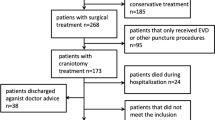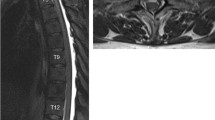Abstract
An 8-year-old boy suffered severe craniocerebral trauma with left-sided fronto-orbitobasal fracture. The CT scan showed minor subdural air inclusions. The child recovered well and had no clinical signs of aftereffects. Eight years after the accident, symptoms of intracranial pressure developed progressively with nuchal rigidity and elevated temperature. The CT showed an extensive left fronto-orbitobasal abscess. The intraoperative finding was a brain prolapse both into the frontal sinus and into the ethmoidal cavity with a large dura-bone defect at the site of the former fracture line, which was closed with refobacin-bone-meal fibrin sealant plasty and glued periostal patch. The postoperative course was unremarkable. Evidently, the accident had caused a brain prolapse into the bone defect, which prevented liquorrhea. Due to the lack of bone and dura barrier, a late brain abscess developed in the course of sinusitis. In such cases, primary surgical revision seems to be indicated.
Similar content being viewed by others
References
Eggert HR, Seeger W, Kallmeyer V (1986) Application of fibrin sealant in microsurgery. In: Schlag G, Redl H (eds) Fibrin sealant in operative medicine, vol 2 (Ophthalmology; Neurosurgery). Springer, Berlin Heidelberg New York, pp 139–143
Frühwald H, Dinges HP (1979) Zum liquordichten Verschluß von Duradefekten mittels Klebetechnik. Eine vergleichende experimentelle Studie. Laryngol Rhinol 58:404–412
Knöringer P (1986) Bone-meal fibrin sealant plasty in the neurocranium: technique and indications. In: Schlag G, Redl H (eds) Fibrin sealant in operative medicine, vol 2 (Ophthalmology; Neurosurgery). Springer, Berlin Heidelberg New York, pp 157–167
Knöringer P (1986) Use of fibrin glue for sealing and prophylaxis of cranial and spinal CSF fistula: indication, technique and results. In: Schlag G, Redl H (eds) Fibrin sealant in operative medicine, vol 2 (Ophthalmology; Neurosurgery). Springer, Berlin Heidelberg New York, pp 148–156
Kuderna M (1982) Die Verwendung des Fibrinklebers bei der operativen Versorgung frontobasaler Frakturen. In: Cotta M, Braun A (eds): Fibrinkleber in Orthopädie und Traumatologie. Thieme, Stuttgart New York, pp 261–263
Stübinger B (1984) Klinische Erfahrungen mit der Spongiosa-Fibrinkleber Plastik. In: Scheele J (ed) Fibrinklebung. Springer, Berlin, pp 201–204
Author information
Authors and Affiliations
Rights and permissions
About this article
Cite this article
Rath, S.A., Knöringer, P. Late brain abscess years after severe cerebrocranial trauma with fronto-orbitobasal fracture. Child's Nerv Syst 5, 121–123 (1989). https://doi.org/10.1007/BF00571124
Received:
Issue Date:
DOI: https://doi.org/10.1007/BF00571124




